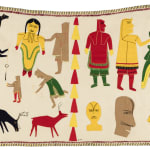-
Artworks
JESSIE OONARK, O.C., R.C.A (1906-1985) QAMANI'TUAQ (BAKER LAKE)
Untitled, 1966-68stroud, felt, and embroidery thread, 29 x 44 in (73.7 x 111.8 cm)
signed, "ᐅᓇ".
LOT 81
ESTIMATE: $25,000 — $35,000
PRICE REALIZED: $26,400.00Further images
This stunning hanging by Oonark marks an important transition from her earliest textile works (c. 1963-65, see Lot 15), which were primarily loosely organized narrative hunting and camping scenes, to...This stunning hanging by Oonark marks an important transition from her earliest textile works (c. 1963-65, see Lot 15), which were primarily loosely organized narrative hunting and camping scenes, to a rather more organized composition that anticipates her classic “designed,” more symbolic, and often larger hangings from 1969-70 and beyond. The hanging is full of rich detail, revealing Oonark’s love of clothing designs, her playful use of colour pattern, and her sensitive and quite charming depiction of animals.
Compositionally the hanging is divided in half vertically. Oonark had occasionally tried this before but only with light stitching; this is the first example we know of where Oonark introduced a repetitive (and possibly symbolic) appliqué design other than for a border. The left-hand side mixes a hunting and fishing scene with figures of people and animals, while the right appears more stratified with three full figures at the top and three tattooed female faces below.
Stylistically this hanging corresponds with contemporaneous drawings by Oonark. We know that in the years 1967-68 she was increasingly encouraged to draw by the local crafts officer Boris Kotelewetz and also by the Reverend and Mrs. Whitton, the local Anglican missionaries. A photo of Oonark and Elizabeth Whitton shows two very similarly styled drawings by Oonark on the wall of the Baker Lake craft shop [1]. Oonark’s drawings from the mid 1960s tend to look more sophisticated that her hangings, but this hanging proves that Oonark was quickly learning to create elegant figures with the appliqué technique. Here the human figures are quite refined, the tethered dog is absolutely charming, and two caribou are extraordinarily graceful, as lovely as any figures we have seen by the artist in any medium. Technique and style are closely bound together in this work; Oonark’s mixing of two and even three colours of felt for most of the human figures reveals her passion for clothing design but also indicates her growing skill as a seamstress. Likewise the stitchery here is as lovely as any we have seen in Oonark’s hangings from any period.
From this beautiful hanging it would be only a short step to Oonark’s larger and increasingly complex textile works from 1969-70 and beyond.
1. See Jean Blodgett and Marie Bouchard, Jessie Oonark: A Retrospective (Winnipeg: Winnipeg Art Gallery, 1986) fig. 2.
References: For hangings by Oonark from earlier in the 1960s see Lot 15 (this auction); Jean Blodgett and Marie Bouchard, Jessie Oonark: A Retrospective (Winnipeg: Winnipeg Art Gallery, 1986) cats. 10-15. By 1969 Oonark was creating some larger, more ordered hangings; see Ingo Hessel, Arctic Spirit: Inuit Art from the Albrecht Collection at the Heard Museum (Phoenix: Heard Museum/Vancouver: Douglas & McIntyre, 2006), fig. 140; subsequently offered in Walker’s Auctions, Ottawa, November 2015, Lot 114. See also First Arts Auctions, May 2019, Lot 24; Blodgett and Bouchard, Jessie Oonark (WAG, 1986), cats. 38-40.
Provenance
Collection of Vivian Julien, a schoolteacher who worked in the Canadian Arctic from the late 1950s until the mid 1970s;
by descent to a Private Collection, Ontario.
Join our mailing list
* denotes required fields
We will process the personal data you have supplied in accordance with our privacy policy (available on request). You can unsubscribe or change your preferences at any time by clicking the link in our emails.






